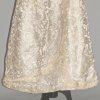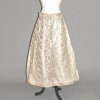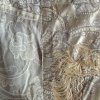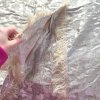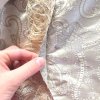DaisyandStella
VFG Member
I'd love some help on dating this skirt and the fabric ID.
I'm wondering if the skirt could be reproduction and not an authentic antique?
Brocade type fabric - the back side is a negative image but I wouldn't consider it reversible as it's quite dull and so I'm not sure it's damask. Last image shows fabric face and reverse side.
Two larger old hook/eye closures at back waist.
Any help would be appreciated, thanks!
I'm wondering if the skirt could be reproduction and not an authentic antique?
Brocade type fabric - the back side is a negative image but I wouldn't consider it reversible as it's quite dull and so I'm not sure it's damask. Last image shows fabric face and reverse side.
Two larger old hook/eye closures at back waist.
Any help would be appreciated, thanks!

